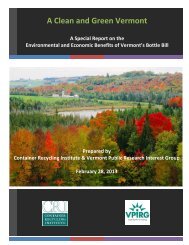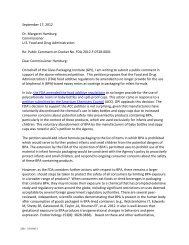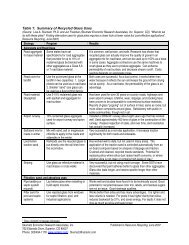You also want an ePaper? Increase the reach of your titles
YUMPU automatically turns print PDFs into web optimized ePapers that Google loves.
February 2013<br />
<strong>Glass</strong> <strong>Packaging</strong> <strong>Institute</strong> (GPI) - Extended Producer Responsibility<br />
(<strong>EPR</strong>)<br />
Background and Key Elements of <strong>EPR</strong> Programs<br />
Extended Producer Responsibility (<strong>EPR</strong>) is a policy approach in which the<br />
producer’s responsibility for the product extends to the post-consumer<br />
management of that product and its packaging. It is commonly utilized in<br />
Europe and is now imperfectly realized in North America.<br />
A producer’s responsibility for post-consumer management of the<br />
product/package includes ensuring the recovery and the reuse or recycling of<br />
materials associated with the product or packaging.<br />
<strong>EPR</strong> could be used to drive innovation by producers, as well as the industries<br />
that recover, recycle and reutilize post-consumer materials in the manufacturing<br />
process. It could also aid an undercapitalized and poorly structured North<br />
American recycling industry.<br />
<strong>EPR</strong> has the potential to be used by brand owners now heavily invested in<br />
plastics and metals to protect that portion of the packaging sector at the expense<br />
of glass. Consistent with recent life cycle analyses, glass’ benefits extend<br />
beyond “traditional” measures.<br />
The <strong>EPR</strong> threat also extends from control issues, to the extent that controlling<br />
parties are interested in primarily addressing cost at the expense of quality<br />
collection and high material yields.<br />
<strong>EPR</strong> should focus on sound environmental outcomes. <strong>EPR</strong> programs be designed<br />
to obtain high rates of recovery of post-consumer materials and cradle-to–cradle<br />
recycling of recovered materials.<br />
Performance targets should be designed to promote “closed loop” recovery as<br />
the highest potential use.<br />
<br />
1
<strong>EPR</strong> programs should take into consideration: diverting recyclable materials from<br />
landfills; increasing or maintaining access to high quality recycled materials; cost<br />
and financial obligations; potential cost savings to municipalities through<br />
increased recycling; and program scope.<br />
Material targets should be set by the government. Strong performance targets<br />
should then be used by producers to develop recovery and recycling programs.<br />
Governments should have an active role in overseeing performance targets.<br />
Industries with traditionally strong recovery rates should not be penalized by<br />
differentiation among materials in the scheme.<br />
Key stakeholders include consumers - financial incentives and penalties drive<br />
consumer behavior. Consumer behavior is key to the success of any scheme.<br />
Consumer deposit refund programs can be effectively utilized within an <strong>EPR</strong><br />
system. Deposits have proven to be effective to ensure quality recycling and<br />
ensure the highest rate of recovery in many jurisdictions.<br />
<strong>EPR</strong> programs should be limited to a manageable scope – consumer goods<br />
packaging. <strong>EPR</strong> systems should capture household, away from home, and onpremise<br />
consumption, while differentiating among them as to collection and<br />
handling methodologies.<br />
Material (packaging) producers should have a significant role in governance, so<br />
as to ensure that any program is fairly administered and is focused on postconsumer<br />
recovery, closed loop usage, and development of post-consumer endmarkets.<br />
<strong>Packaging</strong> manufacturers have a responsibility to serve as, and develop, end<br />
markets to help maximize closed-loop recycling. They also have a responsibility<br />
to optimize their packaging for recyclability.<br />
<strong>EPR</strong> should not distort the packaging marketplace or direct retailers or brand<br />
owners to certain kinds of packaging. <strong>Packaging</strong> optimization and appropriate<br />
closed loop recovery should instead be the goal. GPI opposes penalties in<br />
payment calculations based on weight because they are inadequate method of<br />
calculating the full life cycle impact of a package.<br />
<br />
2






